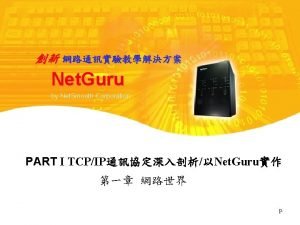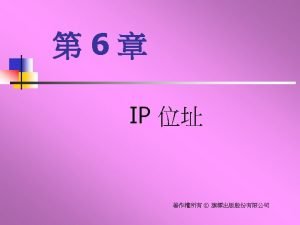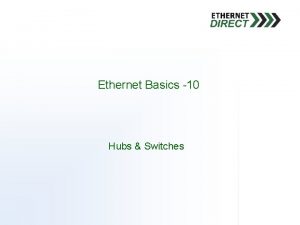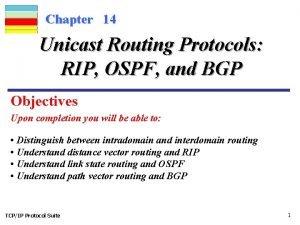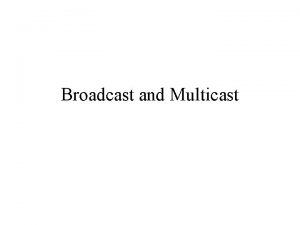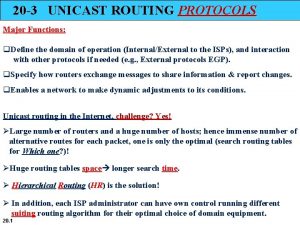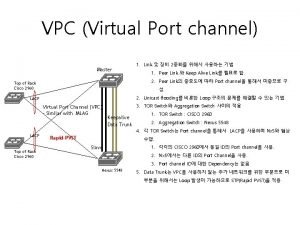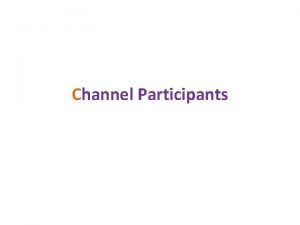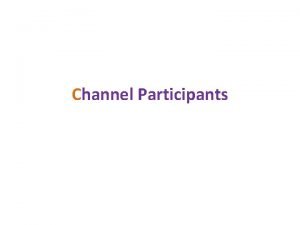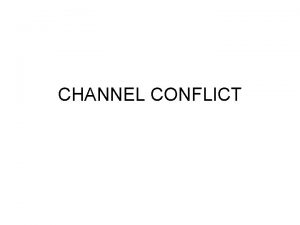DL Unicast Service Control Channel Structure and High







- Slides: 7

DL Unicast Service Control Channel Structure and High Level Design Document Number: IEEE C 80216 m-08/1270 Date Submitted: 2008 -10 -31 Source: Yi Hsuan, Hujun Yin, Ping Wang Email: {yi. hsuan@intel. com, hujun. yin@intel. com, ping. wang@intel. com } Intel Corporation Venue: IEEE Session #58, Dallas, US. Re: TGm SDD other Base Contribution: N/A Purpose: For TGm discussion and adoption of 802. 16 m SDD text. Notice: This document does not represent the agreed views of the IEEE 802. 16 Working Group or any of its subgroups. It represents only the views of the participants listed in the “Source(s)” field above. It is offered as a basis for discussion. It is not binding on the contributor(s), who reserve(s) the right to add, amend or withdraw material contained herein. Release: The contributor grants a free, irrevocable license to the IEEE to incorporate material contained in this contribution, and any modifications thereof, in the creation of an IEEE Standards publication; to copyright in the IEEE’s name any IEEE Standards publication even though it may include portions of this contribution; and at the IEEE’s sole discretion to permit others to reproduce in whole or in part the resulting IEEE Standards publication. The contributor also acknowledges and accepts that this contribution may be made public by IEEE 802. 16. Patent Policy: The contributor is familiar with the IEEE-SA Patent Policy and Procedures: <http: //standards. ieee. org/guides/bylaws/sect 6 -7. html#6> and <http: //standards. ieee. org/guides/opman/sect 6. html#6. 3>. Further information is located at <http: //standards. ieee. org/board/pat-material. html> and <http: //standards. ieee. org/board/pat >. 1

USCCH High Level Design • A USCCH region starts from a pre-determined distributed LRU of an FFR group and occupies several contiguous distributed LRUs. • SFBC is used as the Tx diversity scheme. • Because of separate coding of user-specific control information, a LRU can be divided into smaller units for higher bandwidth efficiency. The smaller resource unit in a USCCH region, ULRU, has a fraction of data tones in a LRU. For 18 x 6 PRU with 2 stream pilots, a 32 -tone ULRU has one third of the data tones in a LRU and a 48 -tone ULRU has a half of the data tones. The exact size of ULRU and how to form a ULRU are FFS. • From the lowest indexed ULRU to the highest, physical channels in a USCCH region occupy ULRUs in the order of non user-specific USCCH, Ack/Nack channel, power control channel, and user-specific allocation channel. 2

USCCH Physical Channels and Allocation 3

User-Specific Allocation Channel • User-specific allocation channel contains resource allocation information for traffic. The information is separately coded among different users and different CIDs. • Each user-specific allocation channel is attached with a 16 -bit CRC masked by CID. • Depending on the size of MAP IE type and MCS, each user-specific allocation channel can take a certain number of ULRUs, say 1, 2, 4, or 8. • Blind detection shall be performed for each user to retrieve user-specific information on traffic resource allocation. 4

Allocation Channel Blind Detection 1. BS groups allocation channels based on required ULRU aggregation levels. Group 1: 1 ULRU. Group 2: 2 ULRUs. Group 3: 4 ULRUs. Group 4: 8 ULRUs. 2. BS assigns resources to allocation channels in the order of group 1, 2, 3 and 4. 3. Numbers of allocation channels in each group are signaled through nonuser specific USCCH. 4. MS tries to blind-detect its allocation channels in each group. 5

Blind Detection Process 6

Suggested SDD Text Change: From page 72, line 30 to page 73 line 6: "The first IEEE 802. 16 m DL sub-frame of each frame contains user-specific control information at least one USSCH region. A USCCH region can include both non-user specific and user specific control information. USCCH regions Control blocks for user specific control information are located 'n' IEEE 802. 16 m subframes apart. If a unicast service control channel (USCCH) region is allocated in subframe N, the next USCCH region is in subframe N+n of the same frame. DL data allocations corresponding to the USCCH region can correspond to resources in any subframes between successive USCCH regions. The values of n can be 1 or 2. Other values of n (3 and 4) are FFS. For example, for n=2, a USCCH region in subframe N can point to resource allocation in subframe N or N+1 and the next USCCH region is in subframe N+2. IEEE 802. 16 m If a USCCH region is allocated in subframe N and contains the specification for UL data allocations, the corresponding UL data allocations occur in subframe TBD. In the FDD mode, the first IEEE 802. 16 m DL subframe of each frame contains at least one USSCH region. user-specific control information. In the TDD mode, the first IEEE 802. 16 m DL subframe after each UL to DL transition contains user-specific control information. The location of control blocks for non-user specific control information is TBD. " 7
